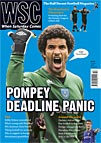 Hooliganism is not attractive, but the media are more than willing to exploit its financial potential
Hooliganism is not attractive, but the media are more than willing to exploit its financial potential
We received a call at the WSC office from a researcher at the BBC. He was canvassing views about football violence for a forthcoming programme. He had an angle, prompted by recent events: “It’s never really gone away, has it? Should we not be concerned about what might happen at the World Cup?” This was in 1990.
A few years later, another call from someone working on a documentary about hooliganism for one of the national news channels. It was to be based around an English club’s forthcoming away match in one of the European competitions. Their idea was to follow one group travelling with a club package, the other – and this is apparently where we came in – a “more dodgy” bunch who might be involved in trouble.
The likelihood of their being caught up in fighting was all the more likely, of course, if they were being tailed by a camera crew waiting for it to happen. Having never kept a database of attention-seeking morons, we were unable to help. That second caller subsequently stood as a candidate for one of the main political parties in a general election. He lost but may be among the intake next time, in which case we’ll watch to see if he ever speaks out about the hooligan menace – the one that has been poised to overwhelm football for the past 20 years.
The rioting before and during West Ham v Millwall at the end of August has been rightly condemned. It was the worst outbreak of football violence here for a long time, with one man seriously wounded after being stabbed while dozens were injured. West Ham and the police have been criticised for being inadequately prepared, with not enough officers deployed in the streets around the ground and too much responsibility for crowd control in the stadium being left to stewards.
The fact that the game was a cup tie is seen as a mitigating factor because it allowed non-season ticket holders to gain entry; many regulars stayed away precisely because they knew that the fixture would attract anyone looking for a fight. There has been a lot written about the historical antagonism between the clubs but the enmity has been fuelled by the fact that they’re not regular opponents, having met in only eight League seasons since the Second World War. The Birmingham derbies in 2002-03 were comparably nasty occasions, with pre-game fighting and pitch invasions, partly because the clubs hadn’t played League fixtures for 15 years.
The fact that the Upton Park violence has attracted so much media interest in itself demonstrates how far away we are from the hooligan heyday of the early 1980s. There is very little trouble inside stadiums now because transgressors can be kept out having been identified on CCTV. The clubs can’t be held responsible for rivals arranging to fight away from grounds but it is commonly accepted the numbers involved are far smaller than in the 1980s. The vast majority of the violent incidents that continue to happen around football are no worse than those that occur outside town centre pubs on a weekend evening, or among drunken holidaymakers in Mediterranean resorts, but these episodes rarely attract front-page headlines.
There are many causes of the violence in society that the tabloids like to characterise as symptoms of “broken Britain”. But the fighting that is attached to football has nothing to with unemployment, social alienation, drug addiction or the rest of it. Football hooligans come from a variety of backgrounds and they fight because they enjoy it. Much as some people enjoy writing about it – witness the delirious glee with which columnists expressed their disgust, “the shame of the nation”, at the events at West Ham – and many people enjoy reading about it.
Hooligan-porn is booming, its success over the past 15 years being bolstered by mainstream films starring major acting names. It has even conferred respectability on those with inside knowledge. Whenever trouble occurs at football matches, newspapers seek the views of noted hooligan authors, whose solutions tend to be involve their being employed as consultants by clubs and football authorities – in much the same way that nightclub security is often provided by precisely the people who ought be barred from gaining entry. During Sky Sports News’ coverage of the fighting at Upton Park they even transmitted a commercial for The Firm, a remake of a 1980s film about hooligans at West Ham. Football violence is a profitable business after all.
From WSC 272 October 2009